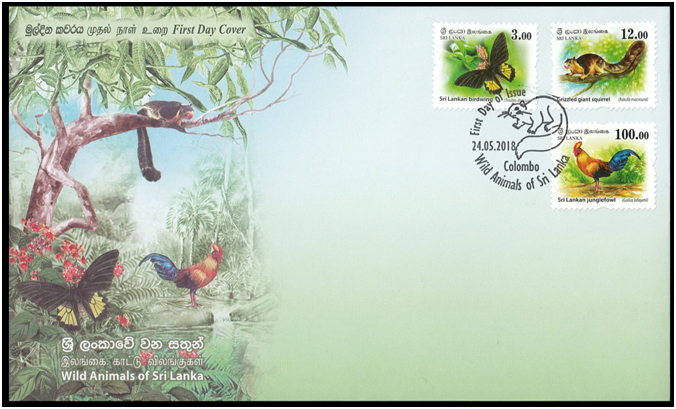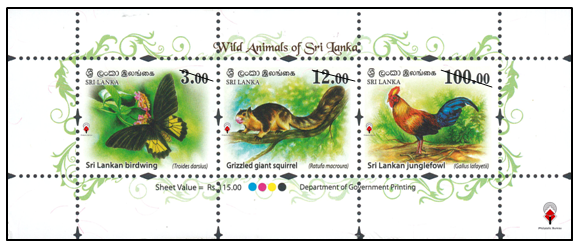

Home/Active Page

The Philatelic Bureau of the Department of Posts has issued three new postage stamps in the definitive series in the denominations of Rs. 3.00, Rs. 12.00 and Rs. 100.00 depicting three wild fauna of Sri Lanka, on May 24, 2018.
| Date of Issue | 24th May, 2018 |
| Denomination | Rs.3.00, Rs.12.00 and Rs.100.00 |
| Catalogue No: | CSL2276 |
| Stamp Designer | P. Isuru Chathuranga |
Stamp Size: | 30mm x 25mm |
| Sheet Composition: | 100 stamps per sheet |


Rs. 3.00
Sri Lankan birdwing (Troides darsius)
Kingdom |
Animalia |
Phylum |
Arthropoda |
Class |
Insecta |
Order |
Lepidoptera |
Family |
Papilionidae |
Genus |
Troides |
DESCRIPTION
The Sri Lankan birdwing is one of the largest butterflies of Sri Lanka. Like most other Troides birdwings, the male is adorned with bright golden-yellow markings on the hindwings, which contrast starkly with the velvety black forewings and interjecting black veins. The female is larger than the male, and has a different arrangement of yellow markings on the hindwing, and pale stripes on the forewing.
Occasionally observed in lowland cities, this species survives today mainly in its primary habitat of thinly wooded mountain forests, throughout the island with the exception of the far north. The Ceylon birdwing has been recorded from sea-level up to an elevation of 2,000 metres, but is now less frequently seen in the lowlands.
BIOLOGYThe Ceylon birdwing is most active during the morning and early afternoon. The butterfly feeds on the nectar of flowers such as Hibiscus, Poinciana (Caesalpinia pulcherrima) and Bougainvillea, and the larvae found on the leaves of Aristolochia plants.
Orange-yellow eggs are laid singly on the young leaves and shoots of the Aristolochia food plants, which are then voraciously devoured by the young caterpillars after hatching. Feeding upon these plants also serves as a defensive mechanism as they contain certain chemicals that make the caterpillars toxic and therefore unpalatable to most predators. The caterpillars eventually pupate and undergo metamorphosis into adult butterflies, and maintain these toxic chemicals in their tissues into adulthood. The chrysalis of this species is dark brownish-yellow, or greenish-yellow in some individuals, and its leaf-like appearance helps camouflage it amongst the vegetation from potential predators. Troidesbirdwings typically pupate on the twigs or stems of plants close to the larval food plant or on the food plant itself.
The principal threat to Troides butterflies is deforestation. The Sri Lankan birdwing is under considerable pressure from an expanding and encroaching human population, and from habitat destruction associated with human development.
The Ceylon birdwing is listed on Appendix II of the Convention on International Trade in Endangered Species (CITES), meaning that any international trade in this species should be carefully monitored. However, more needs to be done to help preserve its fragile habitat, including the Aristolochia food plants on which the larvae rely, if the long-term future of this stunning native butterfly is to be safeguarded.
Rs. 12.00
Grizzled giant squirrel (Ratufa macroura)
Kingdom |
Animalia |
Phylum |
Chordata |
Class |
Mammalia |
Order |
Rodentia |
Family |
Scuiridae |
Genus |
Ratufa (1) |
Size |
Head-body length: 25 – 45 cm (2) |
Weight |
1.5 – 3 kg (2) |
STATUS
The grizzled giant squirrel is classified as Near Threatened on the International Union for Conservation of Nature (IUCN) Red List and is listed on Appendix II of the Convention on International Trade in Endangered Species of Wild Fauna and Flora (CITES).
DESCRIPTION
The common name of the grizzled giant squirrel (Ratufa macroura) came from the grey to brown colouration highlighted with white at the top of the tail, giving it a grizzled appearance. The rest of the body varies in colour geographically and may be brown, red, grey or black, but the fur on the underside is always lighter than the back. This agile climber is adapted for life spent almost entirely in the trees, and has a very long tail for balance, broad hands for climbing and large claws for gripping branches. The ears are short, round and sometimes tufted.
RANGE
The grizzled giant squirrel is found in Sri Lanka and Western Ghats of southern India.
HABITAT
The grizzled giant squirrel inhabits the trees of subtropical and tropical dry forests.
BIOLOGY
Following a gestation of 28 days, the grizzled giant squirrel gives birth to one or two young in a large nest high in the trees. The young are looked after for several months before dispersing. It is thought that the grizzled giant squirrel raises more than one litter each year, but this is unconfirmed.
The grizzled giant squirrel is highly territorial and is very vocal upon encountering an intruder. It is usually found alone or occasionally in pairs. When frightened it will either flee, leaping up to six metres between trees, or will flatten itself against a branch, remaining motionless. It is diurnal, spending the day eating fruit, nuts, insects, bird eggs and the bark of some trees. At midday, the squirrel rests; sleeping spread-eagled on a branch.
THREATS
The grizzled giant squirrel is hunted for food and for its fur by forest-dwelling people, and an increasing local human population has caused even the activities of the forest people to become destructive. Habitat degradation has resulted in the thinning of the canopy which makes the grizzled giant squirrel more vulnerable to predation by the black eagle and other aerial predators.
Rs. 100.00
Sri Lanka junglefowl (Gallus lafayetii)
Kingdom |
Animalia |
Phylum |
Chordata |
Class |
Aves |
Order |
Galliformes |
Family |
Phasianidae |
Genus |
Gallus (1) |
Size |
Male length: 66 – 72 cm (2) |
DESCRIPTION
The handsome cocks of this endemic species, the national bird of Sri Lanka, are remarkably similar to those of domestic chickens. The longish plumage on the breast and upper parts is mainly a rich, fiery yellow to coppery orange with golden streaks, while the abdomen, flanks and bushy tail are a dark metallic purplish-black. The bare facial skin and two lappets hanging from the throat are red, and a fleshy red crest (comb) with central yellow patch adorns the crown. In summer, after the main breeding season, males slowly moult and their comb shrinks in size. The female is much smaller than the male and has no lappets and only a tiny comb, a small purplish-black lump behind the beak. The hen is mostly brown with a darker tail and bold brown and buff barring on the wings.
RANGE
Native to Sri Lanka.
HABITAT
Found in a variety of habitats from coastal scrub to mountain forest, anywhere between sea level and 2,000 m. Although wary of man and normally not venturing far from cover, this bird will visit cultivated areas and plantations in search of food, and likes to frequent open places in wet weather, such as roadsides or glades, in order to feed free from drippings trees.
BIOLOGY
Sri Lanka junglefowl roost in trees, usually singly but sometimes in pairs or family parties, and spend much of the day on the ground, foraging in the morning and evening along open tracks in the forest. This bird feeds on grain, weed seeds, berries, flowers, various succulent leaves and buds, and a large proportion of small animals, such as termites, beetles, woodlice, crickets and centipedes. Animal matter forms the bulk of the diet for chicks.
While the main breeding season is from February to May, a second clutch is often laid in August to September, and breeding appears to go on throughout the year. Nests are constructed in a variety of locations, but typically occur on the ground amongst bushes or under logs, although use of a deserted squirrel and crows nest have been recorded, several metres above the ground. Clutches normally consist of two to four eggs, incubated for 20 to 21 days (in captivity). The chicks are well developed and learn to scratch for food as soon as they leave the nest, although they will instantly scatter and hide at their mother’s alarm call.
All rights received. All right to identify the Department of Posts as the Author and designer of this Bulleting has been asserted in accordance with the Copyright, Design and Patents Act 1988.No part to this publication may be reproduced, stored in or introduced into a retrieval system, or transmitted in any form or by and means (electronic, mechanical, photocopying, recording or otherwise) without the prior permission from the publisher. Any person who does and unauthorized act in relation to this publication may be liable to criminal prosecution and civil claims for damages.